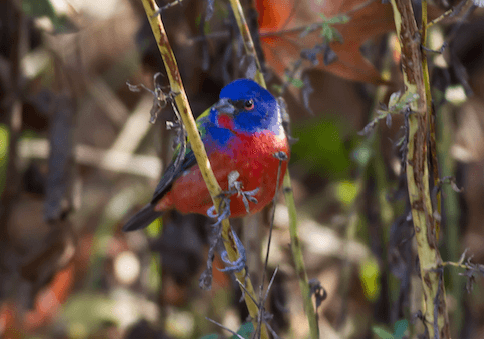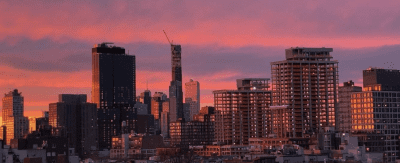Finding the Painted Bunting, or: Prospect Park Birding 101


The Prospect Park Painted Bunting
photo by Rob Bate, head of the Brooklyn Bird Club
“This is what we call silly season.”
Rob Bate, head of the Brooklyn Bird Club, was explaining to me exactly what time of year it was for the local birding community. And, looking around us, “silly season” seemed a pretty apt description. On this unseasonably warm December morning, there were at least 30 people clustered tightly together on the roof of Prospect Park’s Lefrak Center; everyone’s attention—as well as their binoculars and telescopic camera lenses—focused intensely on a cluster of shrubbery in this beautifully landscaped part of the park. If passers-by didn’t yet know what was going on, it would have been hard to describe the scene without using the word “silly.” Or even something not quite as gentle.
And yet, everyone was totally serious; we were all in the park to find the male painted bunting, a vibrant, multicolored songbird, which had never before been seen in Brooklyn. First spotted in Prospect Park on Sunday, painted bunting-fever has steadily grown over the course of this week, with hordes of curious people descending on the park to catch sight of the plump little creature, whose popularity has been aided in no small part by the temperate weather we’ve been having, as well as his own agreeability with regards to being pretty easy for even the most novice of birders, i.e. me, to find.
While I have no real experience birding, I had recently, while standing alone on a river bank in a heavily wooded part of Pennsylvania (long story), seen a bald eagle soar out from the tree line, and the clarity of that moment, the pure rush of recognizing something wild and unpredictable as being momentarily connected in some way to me and my life was so immediately overpowering that all I could think was, yeah, I’d like to have that happen again.
But, of course, I came back to Brooklyn and, as is so easy to do here, forgot pretty quickly about the majesty of nature and just went about my life. The appearance of the painted bunting, however, took me right back to the edge of those woods where I stood motionless and in awe of nature. So off to the park I went.
Birding in Prospect Park, it should be noted, is an increasingly popular activity, one which has been aided by factors other than just natural migration patterns. Namely, the Prospect Park Alliance’s dedication to naturalistic plantings, notably in the new Lefrak Center area, have helped attract more and more birds to various areas of the Park. Before finding the painted bunting, I spoke with John Jordan, the director of landscape management at the Alliance, who told me, “The reason this little guy can hang around here so much is because of all the seeds it can eat. This part [of Prospect Park] has gone from a desert of birding to a hot spot.”
Jordan also pointed out, “We did all native plantings on this strip, so you can see a lot of these are seed-bearing grasses and native herbs and shrubs, and it’s all done by habitat.”
Indeed, the whole lakeside area usually has the feel of a secluded, wooded oasis, particularly on a weekday morning. But this wasn’t a usual weekday morning—there was a painted bunting to be spotted, and many people were out to see it, including me.
Bate loaned me his binoculars and I entered the knot of people looking at the bird (it would be wrong to say “looking for” the bird, because he was easy to find for most people, and if you aren’t most people—I wasn’t, because apparently I can only easily spot birds with six-feet wingspans—some helpful fellow birder will point him out to you). It didn’t take too long (after being helped!) for me to see his bright blue head bobbing along the ground, his bright orange breast and chartreuse back popping out vividly against the dun-colored ground. And even though I knew what I was looking for, and had already seen many pictures of this bird, I couldn’t help but be really, really excited. Even with was the easiest possible way to see one of the most elusive birds to ever come to Brooklyn, I felt a real rush of excitement. I got birding.
Bate told me, “This is so exciting that people are making special trips to see it from all over… it’s unheard of in our territory, to have a bright, tri-colored male. This bird can be what we refer to as a spark bird. It’s, like, you see a bird and all of a sudden you understand there’s a lot more going on.”
But how did this lone painted bunting wind up so far from where his kind usually flock?
Bate explained: “This is what we call the silly season. This is a vagrant bird. This is an El Niño year, so they’re kind of getting an extra push [from the winds], and they end up here. The intuitive thing is that he got picked up by the winds or he got banged against a wall. Bird populations have naturally tried to extend their territory with individual birds striking out on their own. And this one might wind up staying here and mating, and with global warming, we might have painted buntings here in 20 years, a breeding population. So these are the adventurous birds, the explorers.”
And for anyone worried that they haven’t seen the painted bunting yet, and unsure if he’ll stick around for long, Bate says that the environment the Park provides will probably help him stick around. He explains, “It’s all beautifully planted and cared for; it’s all bearing seeds. It’s protected from the wind; it’s just a spectacular place. There’s plenty of food for him here. So if it doesn’t get too cold and he doesn’t get frozen out, there’s no telling how long he could stay.”
But if you don’t wind up seeing the painted bunting (who, shockingly, hasn’t been given a name by the media… the best one I’ve heard is Claudia, after Claudia Cardinale, since the painted bunting is part of the cardinal family; and, yes, this is a male bird, but stop being so gender normative, ok) after all, there’s plenty of other opportunities to see birds in the Park. Bate says, “We count around 200 species in the park each year, that includes resident birds and also all the migrating songbirds that pass through the park each migrating season.”
In fact, Bate continues, if you go on a walk with the Brooklyn Bird Club during peak birding season, “You get to see the full flush of migration. You could see up to 75 species in a single day. It’ll blow your mind.”
But why even limit yourself to birding in Brooklyn? Bate tells me that the farthest-flung placing birding has taken him is Myanmar. And he’s planning a trip to Antarctica a year from now. And while at this point I only have a couple of birds on my official lifetime birding list (but what birds they are!), I can completely imagine planning a trip centered around spending long days walking through nature, pausing to stand for long minutes that just might stretch into hours, scanning the skies and the grounds, looking for signs of life everywhere and anywhere. After all, Prospect Park is a great place to start, but as Bate says, “If you get into birding there’s no shortage of places to go.”
For more information on the Brooklyn Bird Club, including its regular Prospect Park birding tours, visit brooklybirdclub.org
For more information on the Prospect Park Alliance, including how to volunteer for gardening and helping to maintain the park’s vibrant grounds, visit prospectpark.org
You might also like 




















